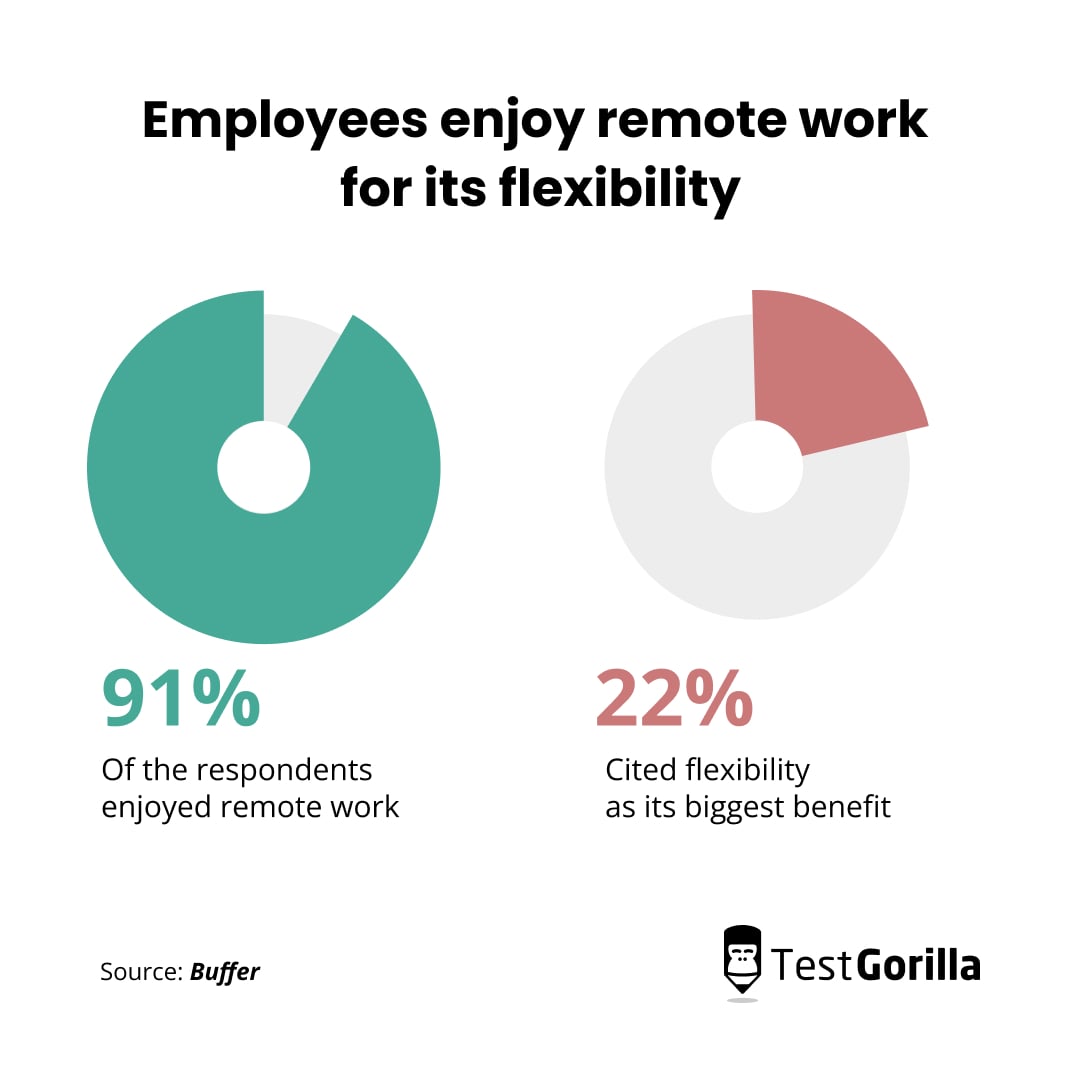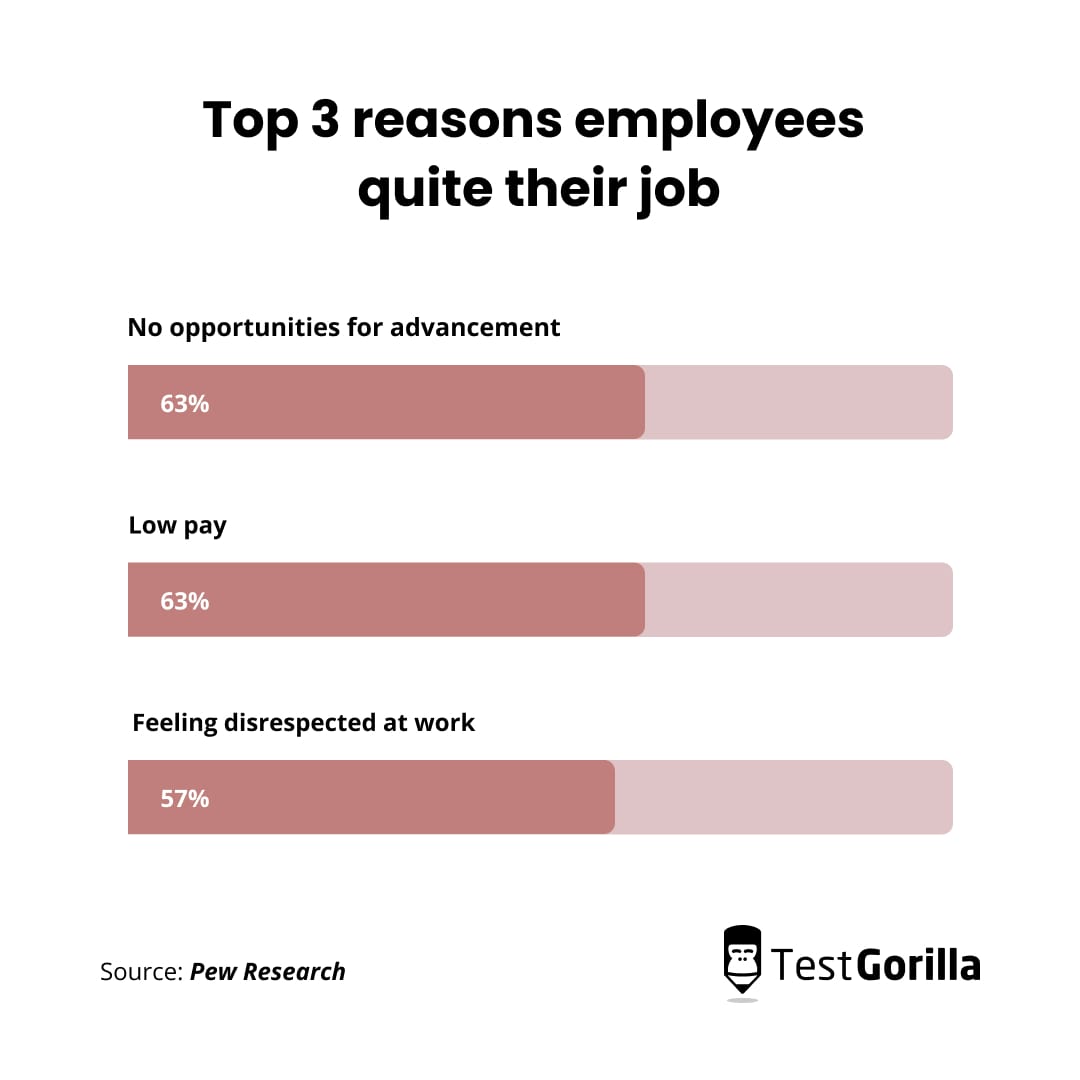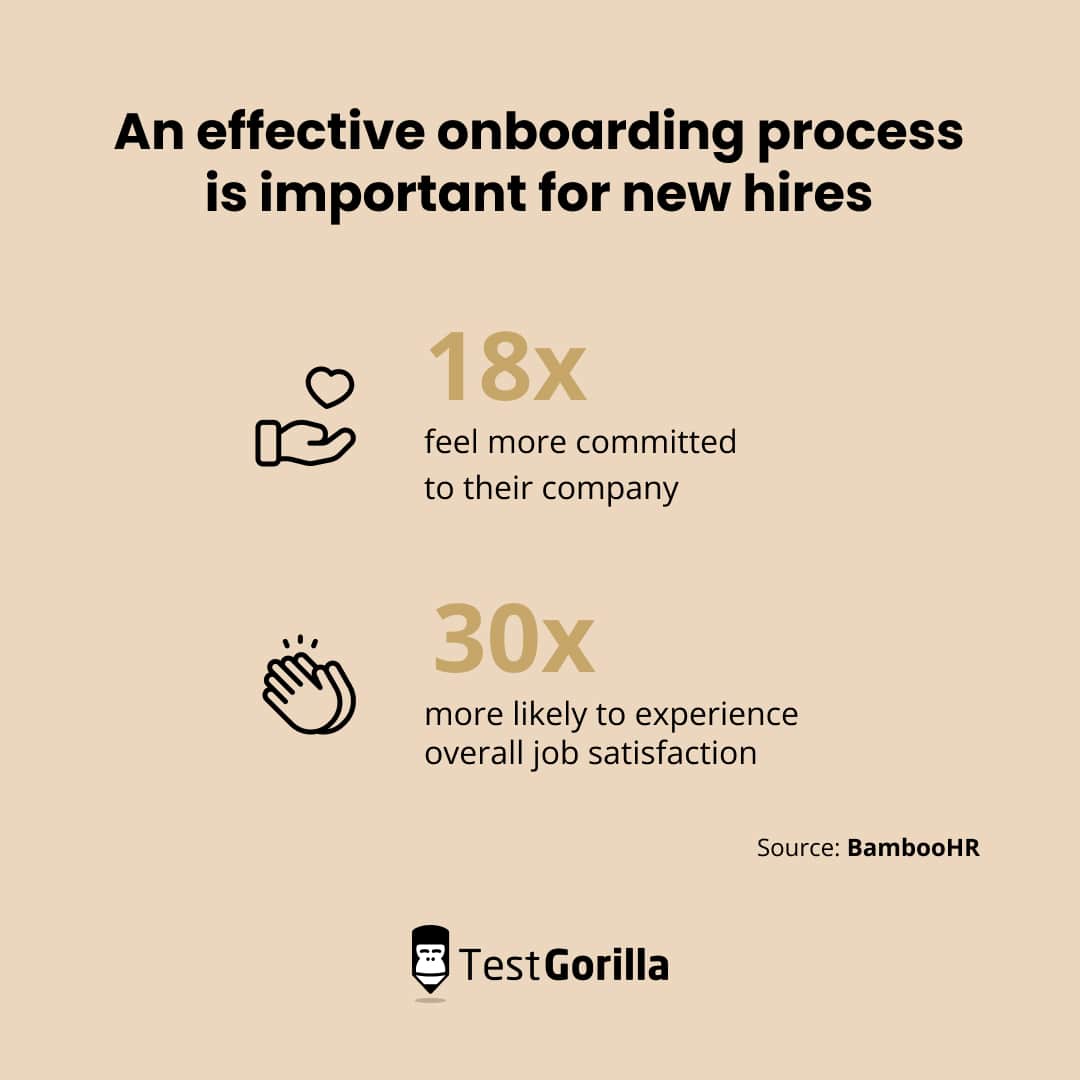In 2018, just 16% of companies were fully remote.[1]
Since then, the pandemic has introduced remote working to the masses – and with that introduction, distributed teams have moved from a niche trend to a mainstream success.
Not every company can go fully remote. But distributed teams offer improvements to flexibility, productivity, cost-efficiency, and employee satisfaction. In industries where a distributed team model is achievable, it’s time to take the idea seriously.
Don’t believe us? TestGorilla is a fully distributed company with colleagues in almost every time zone. And thanks to our extensive test library, you can make sure candidates have the skills to thrive on your distributed team, too.
In this guide, we explore everything you need to know: what is a distributed team, how they work, and how you can overcome some of the most common challenges of the model. We also examine five amazing companies succeeding with distributed teams.
Table of contents
What are distributed teams?
Distributed teams work totally remotely without a physical office or headquarters. In fact, they don’t even need to be in the same geographical region. A distributed team can be made up of employees working remotely from all over the world.
These teams collaborate and communicate using an infrastructure of remote working software. Cloud-based phone systems, video conferencing clients, and shared digital workspaces are crucial for distributed teams to function.
How are distributed teams different from remote teams?
These terms are often used interchangeably, and there’s definitely some overlap. Both terms describe teams that work remotely, with employees who can in theory work from anywhere.
The key difference lies in the extent to which a team’s work is fully remote. A remote team is a satellite of a central office headquarters, where some employees work on-site. Remote team members may be required to work from that office some of the time.
Here’s an at-a-glance guide to the differences between remote and distributed teams:
Remote teams | Distributed teams |
Have a central HQ where some employees work on-site | Are fully remote with no central HQ |
May need to work in the office some of the time | Don’t usually need to work in the office |
Are often based in the same country or state | Can have employees working from anywhere in the world |
Sometimes meet in person | Communicate via Cloud technology and video calls |
The pros of distributed teams
Why choose to lead a distributed team instead of a remote or hybrid team?
To find out, let’s delve into the biggest advantages of the distributed team model.
Greater flexibility for employees
Buffer’s 2023 State of Remote Work report found that 91% of respondents enjoyed remote work – and 22% cited flexibility as its biggest benefit.
Employees want options more than ever, and globally distributed teams offer the most flexible approach to remote work.
Distributed team members can work from anywhere in the world. This model offers workers unprecedented freedom to move, travel, and organize their time in ways that suit their needs.
Extending that trust to your employees shows them that you respect them, and it fosters better communication and collaboration between workers and management.
Increased work-life balance and productivity
While remote work can make it tricky for employees to set clear boundaries around their jobs, statistics suggest that, relatively speaking, a remote lifestyle leads to a better work-life balance for staff.
In fact, a survey by FlexJobs and Mental Health America found 48% of remote workers reported a good or excellent work-life balance, compared to 36% of non-remote workers commuting to their place of employment.
But that’s not all. Research from the University of Oxford shows happy employees are 13% more productive.[2]
If you give your workers the tools they need to strike a good work-life balance, they do better, more efficient work.
Improved agility
An agile workplace is able to adjust quickly to changes without losing productivity or efficiency. When the pandemic hit, we all saw the benefits of agility – the most agile companies adjusted to sudden, major changes without breaking a sweat.
Because agile distributed teams don’t tie your business to a physical location or expensive infrastructure (more on that shortly), they free you and your virtual team up to respond to change quickly and effectively.
In fact, the ethos of distributed teams is built on agility. What’s more agile than trusting your employees to work from anywhere?
Reduced infrastructure costs
In a Global Workplace Analytics study, nearly 60% of employers identified cost savings as a huge benefit of remote work. IBM managed to cut its real estate costs by $50m after implementing telecommuting.
Distributed teams don’t need a brick-and-mortar office building. That means you can save money on all of the following:
Rent and utilities
Cleaning and security services
On-site IT infrastructure
Equipment
Food and beverage options
With all those savings, your company can enjoy greater profits and a more financially stable future.
More diverse talent pool
Distributed teams can recruit from anywhere. This opens up a much wider talent pool, with enormous scope to improve diversity in your workplace.
The distributed model is particularly great for neurodiverse people, who may struggle within the constraints of a typical office environment.
Neurodiverse employees are often the victims of a lack of workplace flexibility; they do best when they are empowered to manage their unique challenges in ways that suit their needs.
As part of a distributed team, they can work in environments that reduce their stress and enable them to deliver great results.
Wider range of local market knowledge
One of the biggest benefits of a diverse workplace is the wide range of knowledge and perspectives its employees bring to the table. For international companies in particular, a diverse work environment is a professional necessity.
Distributed teams are equipped to hire from all cultures and all parts of the world. A distributed team is a uniquely wide-ranging source of local market knowledge, which helps any company hoping to branch out into new markets.
The best insights on HR and recruitment, delivered to your inbox.
Biweekly updates. No spam. Unsubscribe any time.
The cons of distributed teams
Although they have major benefits, distributed teams also come with challenges.
Here are some of the biggest, along with some advice on how to overcome them.
Not suited for all types of companies
This is the biggest obstacle to a distributed way of working – and the hardest one to work around. Some companies need their workers to carry out tasks in person, which means they can’t fully rely on distributed teams.
This is an issue for businesses like:
Brick-and-mortar stores
Construction companies
Food service businesses
Delivery companies
But even in these cases, it may be possible to move some teams to a remote model. If your company has administrative or financial functions that don’t need to be tied to a physical location, you can let those staff work remotely without jeopardizing your business.
Harder to build a company culture
Thanks to remote working technology, it’s never been easier to make a geographic distance feel like nothing at all. But there’s one crucial challenge arising from physical distance: building a cohesive company culture.
When it’s harder to bring people together physically, workplace culture doesn’t develop on its own. Instead, you need to take proactive steps to build a strong culture for your distributed teams. Here are some steps you can take to get started:
Hire for culture add, not culture fit
Incentivize support for your company’s values
Establish an employee-driven culture committee
Model your company culture from the top down
Challenges from entrenched ways of working
In workplaces prone to micromanagement, implementing distributed teams may be a challenge.
Distributed team management requires leaders to trust their staff to work efficiently without in-person supervision.
But trust and respect are important to employees. When a 2021 survey asked workers why they quit, the three most common answers were:[3]
Low pay (63%)
No opportunities for advancement (63%)
Feeling disrespected at work (57%)
If you’re prepared to do the work to increase the levels of trust at your workplace, your employees are more likely to stick with you in the long term.
Openness to the freedom that distributed teams offer can jumpstart change in your company and bolster employee satisfaction.
Can be isolating for employees
Working remotely isn’t always easy for employees. The lack of day-to-day team interaction can lead to feelings of isolation and even working-from-home depression.
And in distributed teams, that isolation can be worsened by the difficulty of communicating across different time zones and cultures.
As the leader of a distributed team, it’s up to you to create a culture that finds ways for employees to spend time together, whether remotely or in the flesh.
Now let’s explore some of the best ways to make that happen.
8 best practices for managing, motivating, and coordinating distributed teams
Managing distributed teams requires a careful approach.
You need to account for the challenges of the distributed model from the beginning, and then implement policies that keep things running smoothly for you and your employees.
These actionable best practices guide you in establishing distributed teams that are truly empowered to succeed.
Successful distributed teams at a glance
What to do | Why it works |
Master remote hiring and onboarding | Ensures employees feel engaged and welcome from day one |
Remember training and upskilling | Keeps your organization agile, innovative, and competitive |
Set clear expectations and boundaries | Improves productivity and reduces the risk of employee burnout |
Think flexibly | Fosters a healthier work-life balance for workers |
Invest in infrastructure | Stops technical limitations from diminishing what your teams can accomplish |
Build a sense of community | Encourages team cohesion and collaboration |
Create a culture of checking in | Prevents feelings of isolation from day to day |
Organize yearly get-togethers | Enables cultural exchange while boosting team spirit and morale |
1. Master remote hiring and onboarding
To hire the best people for your distributed teams, you need to master remote hiring. After all, you won’t be able to travel the world to meet all your candidates in person.
Fortunately, thanks to structured interviews and skills tests, it’s never been easier to recruit remotely. With skills-based hiring techniques, identifying the most suitable candidate is simple – even without a face-to-face meeting.
But hiring is just the beginning. If you want to ensure that your new employees feel integrated into their teams, a good virtual onboarding process is critical.
An effective onboarding process helps new hires feel up to 18 times more committed to their company, and 30 times more likely to experience overall job satisfaction. In a work environment where a lack of regular contact with team members can be a real issue, that’s priceless.
2. Remember training and upskilling
One of the benefits of a distributed workforce is its agility. A team of employees all over the world is uniquely placed to handle sudden changes and disruptions.
Maintain that agility by continuing to train and upskill your distributed staff. Adding new skills to your employees’ skill portfolios keeps your company at the cutting edge of innovation.
It also helps you to retain your distributed staff for longer periods of time, because it eliminates the need to bring on new hires to fill skill gaps. Instead, your current employees have options for career advancement at your company, rather than switching employers.
This is easier if you’ve already developed a strong remote hiring process, which enables you to screen for candidates who are enthusiastic about learning on the job.
3. Set clear expectations and boundaries
Avoid micromanaging your distributed teams by setting clear expectations and trusting your employees to respect them. Be clear about the performance and behavioral standards you expect your staff to meet. Setting objectives can be a huge help.
Alongside those expectations, be careful care to set healthy boundaries for your employees. Take the following steps to reduce employee burnout and encourage greater long-term productivity:
Be clear about each employee’s responsibilities
Create a policy to discourage communication outside of working hours
Give your employees the tech tools to delegate and share their workloads
Make sure your staff take their allocated time off work
4. Think flexibly
Distributed teams challenge the idea that employees need to be stuck at a desk from 9 to 5 every weekday to be productive. But when the people managing those teams stay entrenched in that way of thinking, their staff feel micromanaged and resentful.
That’s why it’s important to concentrate on your teams’ outcomes, rather than their inputs. If your employees are achieving amazing results, does it really matter if they did it from a desk or a deck chair by a pool?
A willingness to think flexibly about work empowers your employees to enjoy an exemplary work-life balance.
5. Invest in infrastructure
Distributed teams save your company a lot of money on office infrastructure. But to ensure that they aren’t limited by the technology at their disposal, you need to invest some of those savings into tech infrastructure instead.
Here’s what your distributed teams need to thrive:
Video conferencing software
Messaging apps
Project management tools
Cloud-based phone system
Document storage tools
Collaboration tools
This isn’t a definitive list. Your company may have unique needs that require additional software and the skills to use it.
Remember, it’s worth investing in technology that works as reliably as possible. Distributed teams rely on tech to enable their workflow, so choose software with consistent uptimes and great customer support.
6. Build a sense of community
We’ve talked about how distributed working can feel isolating for employees. But even with team members spread out across different locations, it’s possible to foster a sense of community at work.
One straightforward way to do this is to promote a culture of appreciation and praise. Try creating a channel on your team’s messaging app where people can commend and celebrate each other’s work.
Little gestures like this make all the difference in a remote environment, where team spirit can otherwise be hard to come by organically.
7. Create a culture of checking in
If you build a culture that encourages regular contact between your team members, you’ll create an environment that keeps your distributed teams feeling motivated and connected.
That means staying in consistent contact with the managers of distributed teams via 1:1 meetings and making sure they’re doing the same for their distributed team members.
But formal team meetings aren’t the end of this process. Consider establishing weekly or bi-weekly video check-in sessions for your distributed teams so team members can get to know each other and build wider team cohesion.
8. Organize yearly get-togethers
If your budget allows for it, consider funding yearly get-togethers for all members of your distributed teams. They don’t have to be formal occasions. Instead, think of them as opportunities to build team spirit and morale.
If your company decides to take this step, it’s important that you allocate funding for it. Otherwise, some employees could be excluded from joining in, which defeats the whole point of having the entire team together.
Get-togethers like this are a great way to bring ideas, cultures, and perspectives together from all over the world. In terms of increased team collaboration, cohesion, and new ideas, these events pay for themselves.
5 inspirational companies enjoying the benefits of distributed teams
Ready to see how distributed teams work in practice?
These five incredible companies are using the distributed team model and seeing amazing results.
Here’s how they do it – and how your company can do it, too.
TestGorilla
At TestGorilla, we operate as a fully distributed team. Our colleagues currently work from all of the following countries:
This approach lets us tap into a worldwide base of global talent. We want our product to be usable by companies all over the world, and the diversity of our staff comes with international market knowledge and cultural insight.
It also means our team members have a huge amount to learn from each other. Our distributed way of working flattens the hierarchy of our team, so everyone is prepared to help everyone else – and to gain new insights from everyone else, too.
We take pride in our 100% remote structure, which gives our staff the freedom they deserve to grow and succeed on their terms. Because we focus on outcomes, we empower our team members to do what they feel is necessary to get the best results.
Zapier
Automation company Zapier is 100% distributed, with employees spread out across 17 time zones.
The company began life as a side project, and its founders couldn’t afford an office space. When they started hiring in 2012, they brought on former colleagues, all based hours away from the founders’ Bay Area home.
This level of workforce distribution was unprecedented at the time. But the company’s clients were happy, and the team was thriving. Employees found it easier to focus without the distractions of an office, and the founders reaped the rewards of a global talent pool.
Crucially, founder Wade Foster says that working remotely forced the business to develop the skills that led to its success. Culture, communication, and documentation were all built into the DNA of the business from its earliest days.
The only downside, he claims, is that it’s harder to celebrate milestones and successes remotely. Even then, technology like Zoom offers a great workaround.
Automattic
Automattic – the company behind WordPress, Tumblr, and many more – has been a fully distributed company since its founding. While the company rents co-working spaces in San Francisco, Portland, and Cape Town, its employees can and do work from anywhere.
Automattic boasts 2,000 workers in 97 countries speaking 124 different languages. It’s proud of the efficiency and sustainability of its distributed approach to work.
The company also offers a valuable case study in how to encourage social bonding intentionally when working on a distributed team.
Its Connectomattic initiative brings together colleagues (and even their families) for Zoom calls based on shared interests. Anyone can propose an addition to the events calendar, from adult coloring to long-distance baking.
Other initiatives, like Happy Hour Zoom calls and the Water Cooler channels in Automattic team Slack spaces, aim to simulate the organic conversations that take place in a physical office.
Buffer
Social media marketing firm Buffer has 78 teammates based in 20 countries. Like Zapier, Buffer made the decision to work in a fully distributed way in 2012 – long before most companies took distributed working seriously.[4]
Buffer’s CEO and founder, Joel Gascoigne, celebrates the freedom and flexibility this model offers his colleagues. The company makes a point of not enforcing or measuring work hours. Instead, it focuses on results and trusts its employees to get excited about its vision and values.
To keep the team feeling cohesive and connected, Buffer holds a yearly team retreat, as well as mini-retreats throughout the year. These team-wide get-togethers connect staff to the company’s history and culture, allow them to collaborate in person, and encourage team-building and bonding.
Travel and accommodation expenses are all covered by the company, so everyone has the opportunity to get involved no matter how far they have to fly.
InVision
Collaboration software developer InVision has been distributed for a decade, with 78% of employees in North America, 13% in Europe, 3% in Asia, and 9% even further afield.
This global approach has earned the company awards for its work-life balance, perks and benefits package, and innovative work.
InVision is intentional about encouraging interactions between employees. People designer Dennis Field explains that while it’s hard to treat a colleague to lunch or coffee in a remote environment, it’s still possible to give them a small bonus to treat themself instead
InVision also values employees who are willing to bring their whole self to work and engage with colleagues on the same terms. Team members are encouraged to look for opportunities to connect with one another, whether on a personal or a professional level.
All of these approaches help to foster a coherent company culture within a widely distributed team.
Build strong distributed teams with pre-employment testing
Distributed teams can be a challenge, but when implemented right, they yield amazing results. Employees enjoy a more flexible, balanced lifestyle, while managers and leaders reap the rewards of a more productive, diverse, and engaged workforce.
The distributed teams model is built to withstand the challenges of a post-pandemic professional landscape. It’s time to let go of old ideas about work and embrace something innovative and new.
Ready to take the leap into a distributed team model? Check out our Motivation test to make sure you’re hiring employees who can meet the expectations of a distributed team.
Then learn more about keeping your remote employees engaged and invested in their work.
Sources
“2018 Global State of Remote Work”. (n.d.). Owl Labs. Retrieved April 12, 2023.https://resources.owllabs.com/state-of-remote-work/2018
“Happy workers are 13% more productive”. (October 24, 2019). University of Oxford. Retrieved April 12, 2023.https://www.ox.ac.uk/news/2019-10-24-happy-workers-are-13-more-productive
Parker, Kim; Menasce Horowitz, Juliana. (March 9, 2022). “Majority of workers who quit a job in 2021 cite low pay, no opportunities for advancement, feeling disrespected”. Pew Research Center. Retrieved April 12, 2023.https://www.pewresearch.org/fact-tank/2022/03/09/majority-of-workers-who-quit-a-job-in-2021-cite-low-pay-no-opportunities-for-advancement-feeling-disrespected/
Gascoigne, Joel. (September 16, 2018). “The Joys and Benefits of Working as a Distributed Team”. Buffer. Retrieved April 12, 2023.https://buffer.com/resources/distributed-team-benefits/
You've scrolled this far
Why not try TestGorilla for free, and see what happens when you put skills first.























